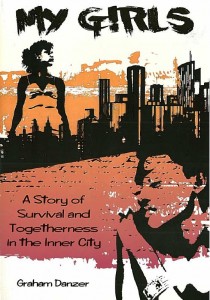Meet the Author: Graham Danzer
There are many stereotypes about girls who grow up in the inner city.
However social worker Graham Danzer broke through these misconceptions when he began working with young women from the inner city. He found the girls had feelings and experiences that could give valuable lessons to other social workers, policymakers and the general public.
So Danzer decided to write “My Girls: A Story of Survival and Togetherness in the Inner City,” which is available on NASW Press (click here to learn more).
SocialWorkersSpeak.org talked to Danzer about the book:
Q: Why did you decide to become a social worker and where did you study?
Danzer: I became a social worker because I wanted to influence social policy. I received my masters degree in social work San Francisco State University, completed a three-year doctoral level certificate program in clinical social work at The Sanville Institute, and am currently pursuing a PsyD through California School for Professional Psychology – Alliant University.
Q: How did you come to work with inner city youth, particularly the group of young women in “My Girls”?
Danzer: I came to work with inner city youth through my experience of being one. When I was the same age as the girls who are the subject of my book, I got into some trouble and was involuntarily referred to a couple of different community-based programs not far from where the girls grew up. One program I was in was a non-public school in which there was strict discipline and coordination with juvenile justice providers. I resented the stricter boundaries and direction, though I graduated from that school, transferred back into a public school, received B’s, got into sports, and dated a cheerleader at a private school. In short, that program threw me a life raft, and that life raft showed me that change is possible. After being accepted to social work school some years later, I interviewed for an internship that was not far from where I grew up and I was thrilled to have the chance to give back to a community so close to home and close to the heart. I remember there being a lot of young women, like the girls in the story, who were loud, energetic, defensive, and sometimes chaotic, though only to mask and externalize dying on the inside; which I got to know in my own adolescence by talking to girls who were going through it. I particularly felt this intuition about the young African-American women I knew when I was a teenager. I guess you could say this lead to the development of a soft spot for them.
Q: What prompted you to write the book?
Danzer: What inspired me to write this book was my experience of bearing witness to what the girls in the story were up against. I found the totality of their suffering to be overwhelming and their stories to be moving. In the end, I just needed to tell someone.
Q: What is it that you came to admire most about the young women in the book? Do you think some of them have good futures despite the hardships they face?
Danzer: What I admired the most about the girls was that they each had their own individual way of keeping their heads up through dark times. They had every excuse to complain and play the victim and yet didn’t. In a way, they could be role models for us all.
Q: What do you hope this book will teach other social workers and policymakers?
Danzer: The main thing I hope to inform social workers and policymakers about is that, in my experience, these girls suffer immensely and are at-risk for having major problems down the road, including substance abuse, school failure, and criminal justice involvement. These are problems that will affect at-risk teenagers as individuals and are also problems that the larger society will have to deal with, whether voluntarily or involuntarily. My hope was that the girls’ stories would raise awareness of what is really happening in their lives and what little we can do to help that may go a long way. In essence, many hardened teenagers survive by depending on themselves and each other and it will take a lot of persistence and reassurance for them to trust us enough to let us in. My experience was that this happened to a degree with me and the girls, though I had to be very persistent, visible, and involved in the surrounding community. Ultimately, we in the helping professions will need to find the resolve to go get them, particularly the girls that are the hardest to reach.
Q: Is this a book the general public would enjoy reading and learn from?
Danzer: The public would appreciate the straightforward, raw emotion and action of this story. There is no rhetoric, no happy ending, no censorship — just the truth. My hope is that my readers will feel this inside when they read and get a little sense of what these girls are up against and maybe even consider responding a little more gently and sensitively to young and suffering African American women in the future. In particular, I have attempted to show that their acting out behavior may suggest that we find a way to take care of them as if they are physically sick rather than scolding them as if they are choosing to behave badly. As demonstrated in the text, this did not lead to a happy ending as is typical in big screen movies. However, competent adult responses to children’s behavior may leave at-risk girls with a positive experience of mental health professionals, which may help them be open to intervention in the future when they might be in need of more help. Furthermore, this positive experience is likely to be shared with their peers and others in the community, as will help social policy and reconstruction efforts operate within the community rather than as outsiders.
NASW Press offers a variety of publications of interest to social workers, including books, journals, brochures and NASW News. To learn more click here. And to find out more about how social workers such as Danzer help young people overcome life’s hurdles visit the National Association of Social Workers’ “Help Starts Here” Kids & Families Website by clicking here.
| Leave A CommentAdvertisement
Leave a Comment
You must be logged in to post a comment.




